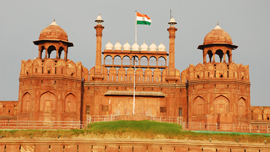Delhi
Delhi is India's main point of arrival for overseas visitors, and the major transport hub for destinations in the states of rajasthan, the Punjab, Himachal Pradesh and Ladakh as well as central north India. Delhi city, the showacse of India, has been the centre of political activity from time immemorial. The ancient fortness, majestic buildings and historic ruins find their modern counterparts in the tall skyscrapers, diplomatic enclaves and well-planned townships of New Delhi. The people here, their lifestyles, traditions and even the climate are a rich and varied mixture of all that is india.
TOURIST DESTINATIONS OF DELHI

Delhi Zoo
Delhi National Zoological Park lies near the famous Old Fort. One of the best zoos in the entire Asian continent, its uniqueness is that it tries to provide an almost natural habitat to the animals and birds houses here. It proves to be an ideal picnic spots, especially in winters, and is spread over an area of 214 acres. National Zoological Gardens of New Delhi houses more than 2,000 species of animals and birds.
The right walkway brings you to the cages of the animals such as Chimpanzee, Hippopotamus, Spider monkey, African Wild Buffalo, Gir Lion and Zebras etc. While, the left one leads you to the enclosures of the water animals. You cal also see a number of migratory birds like Peafowl, Hyenas, Macaque, Jaguar, etc in the swamps made for the water birds. At the heart of the zoo, lies the underground Reptile Home complex for the nocturnal animals like King Cobra, Pythons and a number of other species.
Humayun's Tomb
Humayun died in 1556, and his widow Hamida Banu Begam, also known as Haji Begam, commenced the construction of his tomb in 1569, fourteen years after his death. It is the first distinct example of proper Mughal style, which was inspired by Persian architecture. It is well known that Humayun picked up the principles of Persian architecture during his exile, and he himself is likely to have planned the tomb, although there is no record to that effect. The tomb was constructed at a cost of 15 lakh rupees (1.5 million).
The tomb proper stands in the centre of a square garden, divided into four main parterres by causeways (charbagh), in the centre of which ran shallow water-channels. The high rubble built enclosure is entered through two lofty double-storeyed gateways on the west and south. A baradari (pavilion) occupies the centre of the eastern wall and a hammam (bath chamber) in the centre of northern wall.
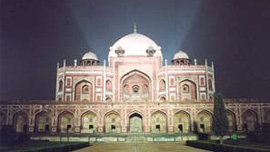
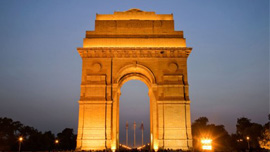
India Gate
India Gate is a war memorial of martyred soldiers, situated in the middle of New Delhi. Standing tall at a height of 42 m, Delhi India Gate, an "Arc-de-Triomphe", seems like a gateway at the heart of a crossroad. His Royal Highness, the Duke of Connaught laid the foundation stone of India Gate in the year 1921. Designed by Edwin Lutyens, the monument was dedicated to the country after 10 years, by the then Viceroy, Lord Irwin. It stands as a tribute to the 70,000 Indian soldiers who lost their lives during World War I, when they fought for the British Army. Resting on a low foundation of red Bharatpur stone, the arch rises in stages to a huge molding. On both the sides of the arch the word INDIA is inscribed, along with the date, MCMXIV (1914) on the left and MCMXIX (1919) on the right. The best time to see Delhi India Gate is during nightfall, when it is magnificently floodlit. Splendid lawns, with a number of fountains, encircle the monument. These fountains present a breathtaking view at night when they make a lovely display with colored lights.
Jantar Mantar
Jantar Mantar was built in 1724 by Raja Jai Singh II of Jaipur in Delhi. Jantar Mantar of Delhi, is an astronomical observatory with masonry instruments. Jantar Mantar in Delhi is a remarkable and curious creation of Raja Jai Singh II, the mathematician and astronomer king. Jantar Mantar has instruments that can graph the path of the astronomical universe.
The name of this noteworthy astronomical observatory, Jantar Mantar means 'instrument for calculation.' There is a colossal Samrat Yantra at the periphery of Jantar Mantar. To the south of Samrat Yantra there is an amazing instrument called Jai Prakash. The Jai Prakash of Jantar Mantar in Delhi has two concave hemispherical structures and used for determining the position of the sun and celestial bodies. Jantar Mantar is built of brick rubble that is plastered in lime. You can see the following instruments inside the Jantar Mantar of Delhi.
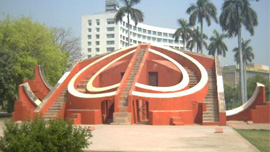

Qutub Minar
The famous Qutab Minar of Delhi is a tower that claims the distinction of being the highest stone tower in the country. Said to be a tower of victory, it soars to a height of 73 m. Qutab-ud-din Aibak, after defeating Delhi's last Hindu kingdom, started the construction of this tower in the year 1193. Although Qutab-ud-din Aibak started the construction of the tower, he could not complete the monument during his lifetime. Later on, additions were made by his successors. Three stories were constructed by Iltutmush, while the fifth and the last two was the work of Firoz Shah Tughlak.
Delhi Qutub Minar is made up of five stories, with the first three being made of red sandstone and the fourth and fifth ones being made up of both marble as well as sandstone. Each of the stories has a projecting balcony with their diameter ranging from 15 m at the base to 2.5 m at the top.
Rajghat
Raj Ghat, the cremation site of Mahatma Gandhi is one of the most visited sites in Delhi. It consists of a simple square black-marble platform that stands on the spot where Mahatma Gandhi was cremated. Nearby, there are cremation sites of Jawaharlal Nehru - the first Prime Minister of India, Indira Gandhi, Sanjay Gandhi, Rajiv Gandhi and Lal Bahadur Shastri.
Raj Ghat is situated to the south of Red Fort and is very peaceful. The black marble tomb is inscribed by the words 'Hey Ram!', the last words that were spoken by Mahatma Gandhi, as he fell down after being shot by Nathuram Godse. The whole edifice of the Samadhi reflects the simple and nature-loving personality of the great leader. The cenotaph stands surrounded by earthworks that protect it from the flooding of the Yamuna. These walls have resulted in the open space of the memorial being converted into an enclosed garden.
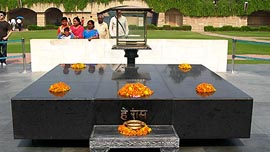
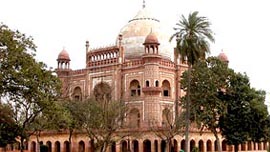
Safdarjung Tomb
Safdarjung's Tomb entombs Muqim Abul Mansur Khan, also known as Safdarjung. He was the viceroy of Awadh under the Mughal Emperor, Mohammed Shah and later became his prime minister. Nawab Shuja-ud-Daulah, Safdarjung's son, constructed Delhi Safdarjung's Tomb, the last garden tomb in the city, in the year 1753-54. The tomb consists of a number of charming pavilions namely Jangli Mahal, (Palace in the woods), Moti Mahal (Pearl Palace) and Badshah Pasand (King's favorite).
There is also a madrassa (Muslim School) inside the premises of the Tomb Of Safdarjang, Delhi. The red sandstone and buff stone monument comprises of the tomb, the courtyard and a mosque. There is a library over the main gateway, maintained by the Archaeological Survey of India (ASI). One of the last remnants of Mughal architecture, Safdarjung's Tomb is to some an extent like the Humayun's Tomb. It stretches over an area of 300-sq-metre and is set in the middle of a widespread garden
Red Fort
Shah Jahan shifted his capital from Agra to Shahjahanabad and laid the foundation of Red Fort, or the Lal Quila, on 16th April 1639. It took nine years to build this mighty citadel and it got completed on 16th April 1648. It is said that about one crore rupees, an astronomical sum in those days, was spent on its construction. Half of this sum was spent to build the exotic palaces within the fort. Built of red sandstone, it is octagonal in shape, with two longer sides on the east and west.
The perimeter of its strong ramparts is about 2.41 km. Red Fort rises to a height of 33.5 m on the town side and 18 m along the river. A wide moat surrounds the fort, which was originally connected with the river and was always filled with water. The two main gateways, known as Lahori Gate and Delhi Gate (named so, as they face Lahore and Delhi respectively), are three storeys high and are flanked by semi-octagonal towers. They are situated on the centre of the western and southern sides respectively.
